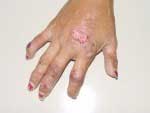Make the Correct Diagnosis
An essential first step is to in ensure that a full diagnosis of the porphyrias has been made including:
- The type of porphyria
- Its biochemical activity
- where possible, the mutation underlying the porphyria.
Treatment is then dependent on the type of porphyria.
Porphyria Cutanea Tarda

Read Porphyria cutanea tarda.
Looking After the Skin in Variegate Porphyria
The skin disease of variegate porphyria (VP) is a very specific disease and one cannot ascribe every bump, scratch, or rash to it. The typical skin disease of porphyria consists of lesions described in Skin Disease in Porphyria, and are usually confined to the backs of the hands and face, though more severely affected people may show it on their faces, forearms and legs.
Understanding How Skin Damage Comes About
It is often not clear to porphyrics that their skin disease is a direct result of sun exposure. This is because there is usually a lag between exposure to the sun and the development of the sores or blisters. Porphyrins, the substances which accumulate in porphyria, build up in the skin and are very sensitive to light. When light strikes them, their electrons are excited and give off energy which damages the surrounding skin.
In summary there are three things which give rise to the skin disease.
- The abnormal build up of porphyrins.
- Exposure to light and particularly sunlight.
- Trauma or injury to the skin.
Prevention of Skin Damage
It is essential to bear in mind the triad described above when planning on minimising skin disease in porphyria.
1. Avoidance of anything which increases the production of porphyrins
People with VP will know that the chief offenders are drugs. They may also cause the acute attack with severe consequences. It is therefore imperative that they do not take any drugs which are not listed as 'safe' in porphyria.
2. Limiting exposure of the skin to light
Sunlight is rich in wavelengths of light which harm the skin in porphyrics. The most useful advice that can be given is that people suffering from porphyria should avoid light where possible, particularly in the middle of the day and in summer when the sun is at its strongest. Remember that the effects of sun-exposure are cumulative; it is all the hours of exposure to the sun in walking to and from the shops, waiting at the bus stop etc. which results in damage—not just lying on the beach! You must therefore take precautions at all times when you are out of doors.
If you cannot see through an object, then by definition it is opaque and sunlight cannot penetrate it. For this reason, non-transparent clothing is a far better sunblock than any suntan cream or lotion. The best protection is therefore appropriate clothing, including a long-sleeved shirt or dress, closed shoes and a hat with a brim (and possibly even gloves).
Ultraviolet wavelengths of light are classified as UVA (which causes sunburn) and UVB (which contains the wavelengths most damaging to the skin in porphyria). Most suntan preparations are predominantly directed at blocking UVA; some of the newer preparations do however have some potential to block UVB as well. It is therefore sensible to apply a suitable cream to the face, forearms and backs of the hands of for additional protection. If you choose to use a sunblock, be sure to choose one with the highest SPF number and which is designed to block both UVA and UVB: these creams usually contain titanium dioxide. Read the packaging carefully to make sure it is suitable. It is important to reapply the cream frequently during the day and to reapply it to the backs of the hands after washing.
Fluorescent lights also give off UVB radiation but the amount is very much less than that given off by the sun. Under normal circumstances it is not necessary to worry about this, though it may be sensible to install normal incandescent bulbs in the home rather than fluorescent lighting.
3. Minimising trauma to the skin
It is often difficult to avoid bumping or damaging the hands. However, some common sense precautions will assist with this. For instance, when doing housework or working on their motorcars or at their hobbies, porphyrics should consider wearing cotton gloves surrounded by plastic gloves, or in the latter case, leather workmen's gloves. If the skin is being adequately protected against light, the tendency to develop sores in response to trauma will be greatly diminished and much of the need for these measures will then fall away.
Caring for Established Skin Lesions
Blisters
If large, wash gently with soap and water, and then, lance with a sewing needle sterilised in the flame of a match or lighter.
Sores (erosions)
Wash gently with soap and water. Keep them clean and cover with a light gauze dressing. As soon as they are dry, they should be left open as they will heal more quickly. Avoid astringent disinfectants such as Dettol which sting and burn, as they may aggravate the damage.
Infection
Do not let blisters and erosions become infected as this increases the chances of poor healing with unsightly marks. Always keep them clean and protected as described above. If necessary, apply povidone iodine (Betadine™). When larger areas become unsightly or mucky, ask your doctor to consider prescribing an antibiotic.
Severe, extensive and unsightly marks
Consult a doctor about obtaining a pigmented cosmetic cream such as Covermark™. This will not only hide the marks, but, being opaque, will provide ongoing sun-protection, therefore allowing the skin to heal.
Once the chronic lesions (blotches) have resulted, there is unfortunately very little that can be done. However once the porphyria is inactive and no new lesions have developed, it may be possible to consult a dermatologist with a view to obtaining creams that will lighten these patches.